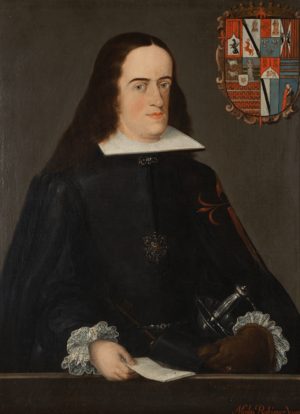Francisco Fernández de la Cueva, 10th Duke of Alburquerque facts for kids
Quick facts for kids
The Most Excellent
The Duke of Alburquerque
|
|
|---|---|
 |
|
| 34th Viceroy of New Spain | |
| In office 27 November 1702 – 14 January 1711 |
|
| Monarch | Philip V |
| Preceded by | Juan Ortega |
| Succeeded by | The Duke of Linares |
| Personal details | |
| Born | 17 November 1666 Genoa, Italy |
| Died | 28 June 1724 (aged 57) Madrid, Spain |
| Signature | |
Francisco V Fernández de la Cueva y Fernández de la Cueva was an important Spanish noble who lived from 1666 to 1724. He was the 10th Duke of Alburquerque and a very high-ranking noble known as a Grandee of Spain. He also became a Knight of the Order of the Golden Fleece in 1707.
One of his most important roles was serving as the Viceroy of New Spain from November 27, 1702, to January 14, 1711. New Spain was a huge area that included much of what is now Mexico and parts of the United States. He was in charge during the War of Spanish Succession, a big war in Europe. The city of Albuquerque in New Mexico is named after him!
Francisco was related to other important people. His uncle, Francisco IV Fernández de la Cueva, was also a Viceroy of New Spain (from 1653 to 1660) and a Viceroy of Sicily. Francisco V's father, Melchor Fernández de la Cueva, was the 9th Duke of Alburquerque. Through his mother, Ana Rosolea Fernández de la Cueva, he was also connected to Lope Díez de Armendáriz, another former Viceroy of Mexico. So, his family had a long history of serving as viceroys.
Before becoming a viceroy, Francisco V was a captain general in the Kingdom of Granada and along the coast of Andalusia in Spain.
Leading New Spain
When Francisco V arrived in Veracruz, New Spain, in November 1702, he had to deal with a French trading post. This post had been allowed to operate for ten years, dealing in enslaved people. Francisco V made sure that once their agreement ended, the French trading post stopped its operations because it was against Spanish law to openly run such facilities in Spanish territory.
He officially entered Mexico City on December 8, 1702. He was a strong supporter of King Philip V of Spain and the Bourbon royal family. He worked hard to stop any disagreements in New Spain that might help the rival Habsburg family.
Francisco V's time as viceroy was known for being very grand and luxurious. For example, on January 6, 1703, the palace guards started wearing fancy new uniforms in the French style, complete with three-cornered hats. This new fashion quickly spread throughout the court and beyond. However, this luxury was a sharp contrast to the poverty of most people living in New Spain.
Family Life
Francisco V married Juana de la Cerda y de Aragón-Moncada in Madrid on February 6, 1684. She was 18 years old at the time. Her father, Juan Francisco II Tomás Lorenzo de la Cerda, was the 8th Duke of Medinaceli and also a Knight of the Order of the Golden Fleece.
Their first son, who inherited his father's titles, was named Francisco VI Fernández de la Cueva. He was born in Madrid on September 28, 1692.
Military Actions
As viceroy, Francisco V worked to improve the coast guard, called the armada of Barlovento. This helped them fight against pirates. He also used the armed forces to remove English and Dutch groups from the Gulf coast. He sent help and supplies to Saint Augustine, Florida, which was under attack by the English. To pay for these efforts, he took property from the English and Dutch. He also worked to protect the new Jesuit missions in California.
He also focused on sending money to the Bourbon family in Spain to help with the War of Spanish Succession. He even asked the clergy (church leaders) to give one-tenth of their income to the government, which the archbishop strongly opposed. When his term as viceroy was extended, he sent two million pesos back to Spain as a thank you. To get this money, he sometimes sold government jobs. Because so much money was sent to Spain, the local government couldn't pay many police officers and other workers, so they lost their jobs. This led to more crime on the streets and highways.
His Legacy
Francisco V Fernández de la Cueva is remembered because the city of Villa de Alburquerque in Nuevo México (now New Mexico) was founded during his time as viceroy, on April 23, 1706. Also, on October 12, 1709, the city of San Francisco de Cuéllar (now Chihuahua) was founded. In the same year, the Church of Santa María de Guadalupe was built.
Even with some challenges during his rule, Francisco V was seen as a friendly, fair, and capable leader. He kept things peaceful and safe in New Spain. He handed over his power to the next viceroy, Fernando de Alencastre, 1st Duke of Linares, around January 1711. After that, he returned to Spain in 1711 and passed away in Madrid in June 1724, when he was 57 years old.
See also
 In Spanish: Francisco Fernández de la Cueva y de la Cueva para niños
In Spanish: Francisco Fernández de la Cueva y de la Cueva para niños

